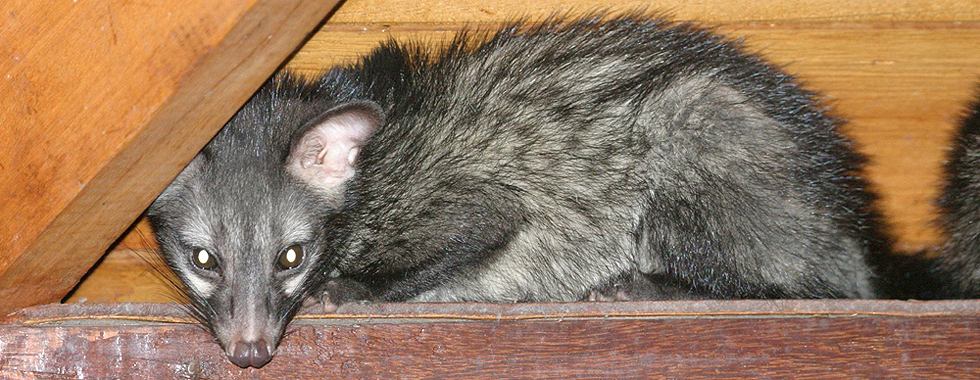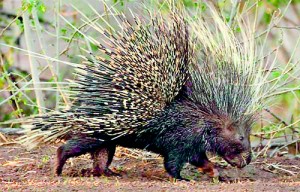Meet our resident fellow creatures
A synanthrope is a member of a species of wild animals or plants of various kinds that benefit from an association with humans and live in the somewhat artificial habitats that humans create around them, like houses, gardens, farms, roadsides, garbage dumps, and so on.
One side of my house at Rajagiriya borders the marsh that is on the banks of the main canal that goes across the Nawala – Nugegoda Road towards Parliament. For the past 20 years I have observed the wildlife in and around these marshes and on the land in which our houses are built. These lands were formerly low lying areas later filled by a developer. Many interesting forms of wildlife live in the

A common intruder: A Polecat lurks in the ceiling of a home. Pic by Gehan de Silva Wijeyeratne
marshes and in the housing areas.
Having wildlife in urban areas seems a paradoxical situation. Almost all urban wildlife are those that lived in these environments even before development and construction changed the landscape. Some species have been extirpated from these areas, some have moved to more conducive habitats, whilst some have stayed and adapted themselves to the changed environment.
The wildlife in our areas now consists of those species that can live, thrive and breed in urban environments. Some urban wildlife, such as house mice, are ecologically associated with humans. Different types of urban areas support different kinds of wildlife.
There are many animals that are resident within the buildings here. Some rats live in and some come in from outside. The common squirrel, also a rodent, lives in and outside houses. Earlier two shrews used to wander into our house at dusk making a call that sounded like ‘chick chick’. Unfortunately this species is not seen anymore.
Rat snakes come into our garden regularly seeking a cool spot to avoid the heat of the day rather than to catch prey. However, these snakes prey on rats and squirrels and also probably consumed the shrews. Ratsnakes are the most common snake here but Cobras and Russels Vipers (Polonga in Sinhala) are also seen. I have also seen a Haldanda twice.
Polecats (Paradoxurus hermaphoditus) are resident in the ceilings of some houses. In Sinhala they are referred to as Uguduwa or Kalawadda though Kalawadda is the correct name for this species. The Uguduwa is the ring-tailed Civet. Polecats come in at the break of day to roost in dark places and leave at dusk in search of food. They feed on rats and various types of fruit. In the wild they eat the fruit of the Kitul tree (Caryota urens) and spread the seeds with their faeces. They breed in ceilings of houses and in the holes of trees. The urine which they discharge and drips through the ceiling has an offensive smell.
The largest mammal here is the Fishing Cat (Prionailurus viverrinus). In Sinhala it is known as the Handun Diviya. A medium-sized wildcat, this is the second largest of the four wildcat species in the country. With the rapid urbanisation of marshlands and other wetlands, fishing cats in urban habitats are threatened by habitat loss. The solitary living fishing cats are primarily nocturnal. They are very much at home in the water and can swim even under water. Their forefeet have webbing upto half way between each toe.
Porcupine (Hystrix indica) are seen often at night, mostly in the home gardens or crossing the lanes and roads. They live in holes they dig for themselves in the thickets of unbuilt lands and other vacant areas. Sometimes only a single porcupine is seen but there is also a group of three that wanders around. They are nocturnal and forage even on the banks of the many canals here. They do not like water and so do not inhabit the marshes. They do not breed freely in the urban areas but do so in the wild.
Strangely the wild boar, found in large numbers elsewhere, has not been seen in this area, maybe because wild boar never have, not even in the 1950s when this area was covered in shrub jungle and marshes.
I see the Grey Mongooses very often in the hedges searching for food or scurrying across the road seeking cover. Mongooses are omnivorous, feeding on a varied diet that consists of insects, lizards, worms, snakes, birds and their eggs and any forms of carrion.

Porcupine on the prowl: An unexpected sight in an urban area
Flying Foxes and Bats are seen regularly at twilight and later at night. Since there is not a significant number of fruit trees here, the Flying Fox flies further afield to seek its food. The smaller bats fly around and catch insects on the wing using their inbuilt radar to identify the exact position of the insects. These small bats are reputed to catch 150 mosquitoes each night for their food. If so they are doing a better job than the Kotte Municipal Council to eradicate Dengue.
The usual garden lizards of a number of species are found almost everywhere. The Water Monitor or Kabaragoya is seen in the marshes, in the gardens and swimming in the canals. This reptile feeds on carrion, small mammals, dead fish and garbage. It has a strong whip like tail with firm serrated scales on the upper side and stray dogs that have got too close to it have had their legs broken by the swishing of this tail. They breed freely and grow quite big, some as big as a young adult crocodile.
The land monitor is a milder reptile, preferring to move about looking for its food in the gardens, roadsides and canal banks. It does not get as big as a water monitor nor does it like to swim. One medium sized land monitor climbed up the downpipe leading from our gutter but I do not think that it got any food from our gutter. Land monitors too breed freely.
A dangerous situation that is developing in the urban and rural areas is the packs of stray dogs that get together and walk about at night. They raid garbage bins for anything to eat. They surround and kill any small mammal that they encounter.
Over the years there have been sporadic reports of crocodiles seen in the Wellawatte Canal. In recent times their numbers in the canals, in our area, have increased. Three crocodiles have been seen regularly in the canal that crosses Kirimandala Mawatha. There are many in some of the other canals. The unofficial count is a total of eight crocodiles sighted.
Sri Lanka has two species of crocodiles, the Mugger or Marsh crocodile (Crocodylus palustris) and the Saltwater or Estuarine crocodile (Crocodylus porosus ). The crocodiles in the Colombo canals are Saltwater crocodiles or geta kimbula in Sinhala. They come along the sea from another river mouth and up rivers and canals. They also migrate across land at night. Some may have come from their original habitat in the Bolgoda Lake. Sometimes they get washed away in strong flood waters.
Many years ago my cousin, who lives in an adjoining lane, was given a baby crocodile. At first it was put into a large basin and when it outgrew the basin it was transferred to a disused bathtub but when the crocodile filled the bathtub it was released into the marshes close by. Maybe now, many years later, it is still lurking in these canals.
This area and the marshes abound with birds like the Black-headed Oriole, Common Babbler (also called the seven sisters) Magpie Robins, Parrots, Scops Owls, Brown Fish Owls, Egrets, Pond Herons, Water Hens. The Herons both grey and purple are often seen sticking out their long necks. Flights of teal are often seen flying around making their unmistakable whistling sound. A family of Scops Owls used to perch just outside our front door on the telephone wire. After a time their visits stopped.
The Stork-billed, Common, White Breasted and Pied Kingfishers are close to the waters in the area. It is a beautiful sight when the Pied Kingfisher hovers over the waters of the canal and moves up and down slowly looking for the slightest movement of fish in the water. When it spies a fish the Pied Kingfisher dives straight into the water and emerges, most times, with a fish in its beak. It then flies to a convenient branch or log and swallows the fish head first. The Pied Kingfisher is the only one among the kingfishers that flies for long periods over water, the other three species sit on a log or branch and wait for a fish to come into their sight. They then swoop down and catch it. The White-breasted kingfisher also perches on electric and telephone wires waiting for its prey. This kingfisher has degenerated in its feeding habits and is quite happy eating frogs, garden lizards etc.
The Red-vented Bul Buls are plentiful and seem to be always in search of suitable sites in which to build their nests. When the nests they start building in houses are broken, they come back undeterred and start building again. The security that a house gives them is the reason why these birds seek houses as nest sites.
The House Sparrow, Spotted Munia and the Common Mynah were seen in the area in significant numbers up to some years ago, but now all we have is a rare sighting of a Mynah. One reason for the absence of the Munia and House Sparrow is that all the Guinea Grass that the vacant housing blocks nearby had and the seeds of which these birds fed on, have now been cleared.
Pelicans are seen perched on the tall street lights on the centre of the road to Parliament from Borella. The Spot-billed Pelican is threatened with extirpation in Sri Lanka, with recent surveys showing that there are less than 1000 breeding pairs. Earlier too the local pelican population declined but with certain conservation measures recovered. However, now a decline in numbers is noticed again.
The Common Babblers are seen in flocks feeding on the ground and in the hedges from early morning. Generally the flock consists of around seven birds giving rise to their popular name of Seven Sisters. They are noisy birds and keep constant communication with the rest of the flock. The magpie also comes down to the ground to feed occasionally. The Crow Pheasant confines itself mostly to the hedges and undergrowth to find its food.
As recreational development in the urban areas with the construction of walking paths, jogging tracks, parks etc continues for people, with a little more planning and effort, refuge for birds, butterflies and garden lizards etc. could be set up creating a green environment that is able to host many harmless species of wildlife that can live easily and in compatibility with humans. This will make the cities less sterile and sustain clear air and water. These areas will also give the younger generation an opportunity to acquaint themselves with nature first hand.



